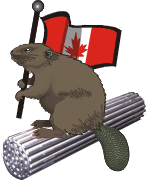This website, established in April 1996, is an unofficial and
privately-maintained list of Frequently-Asked Questions (FAQ's) regarding
CANDU reactors and nuclear power generation in Canada. It is designed to
meet general as well as technical interest needs. The FAQ's and their
answers are compiled by the author, and do not
necessarily represent the official views of Atomic Energy of Canada Ltd.
(AECL), Canadian Nuclear Laboratories (CNL), the Canadian Nuclear Society (CNS), nor any other component of the
Canadian nuclear industry.
The information given here is in the public domain. It is meant to complement the
wealth of nuclear-related information already on the Web. For example,
good introductions to nuclear power in general can be found in John
McCarthy's Nuclear Energy FAQ or Joseph Gonyeau's Virtual Nuclear
Tourist. Lawrence Berkeley National Lab's excellent ABCs of Nuclear
Science and Particle Adventure websites summarize the physics of
radioactive decay and subatomic particle theory. For an excellent overview of
nuclear and other areas of physics governing our natural world (including some great
science fair ideas), visit Georgia State University's "HyperPhysics" website. Other relevant
links can be found in Section J: Further
Information.
Contributions (questions and/or answers) and comments are welcome. Please
send to the author, Dr. Jeremy Whitlock, at
jeremyjwhitlock@gmail.com. Text
is copyrighted by
Jeremy Whitlock, but can be quoted if properly credited to the author.
Unless noted otherwise, images are from public literature published by
AECL, Ontario Power Generation Inc. (formerly Ontario Hydro), and other
members of the Canadian nuclear industry.
Explanation of graphics on this page: The header graphic at
top right shows symbolically a maple leaf superimposed over a CANDU
containment building on the shore of a Canadian waterway (there are no
cooling towers used with Canadian power reactors). This logo was first used by the Annual Conference of the Canadian Nuclear Society (CNS) in 1990. The main graphic above depicts a beaver with the Canadian flag upon a CANDU fuel bundle – three symbols of
Canadian industriousness and pride. The CANDU fuel bundle pictured weighs
23 kg, is about the size of a fire log, and produces enough electricity
to power 100 average Canadian homes for a year. A CANDU reactor contains several thousand similar-looking bundles.





